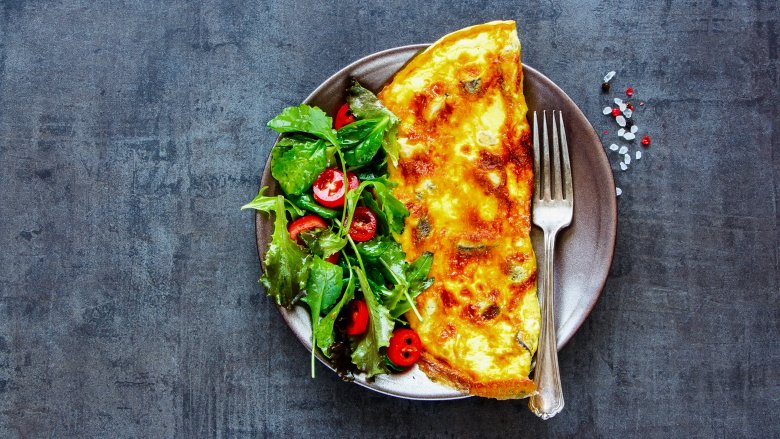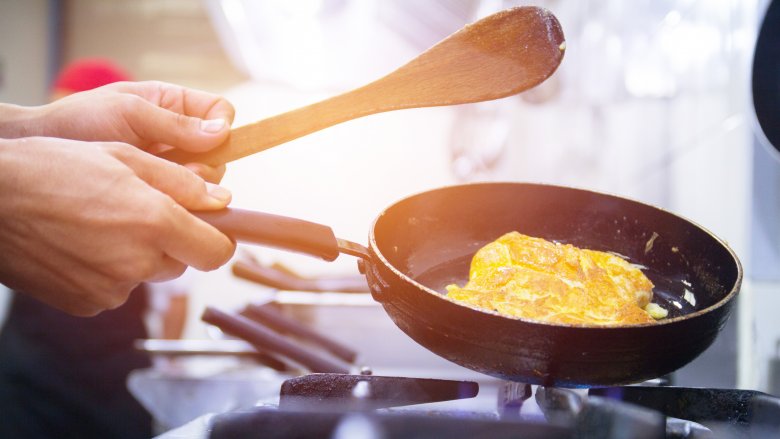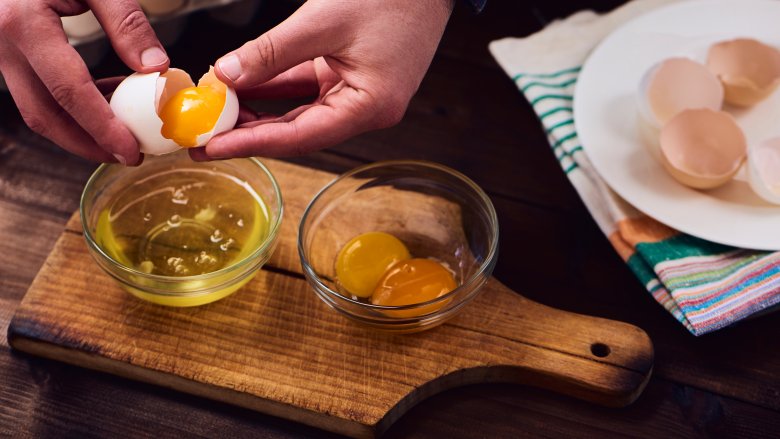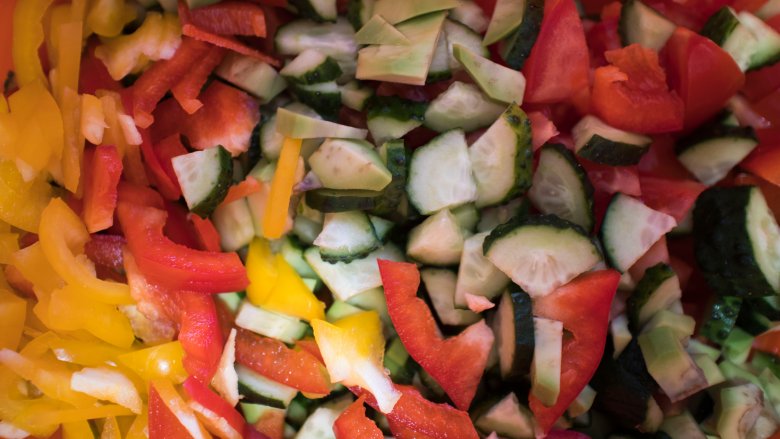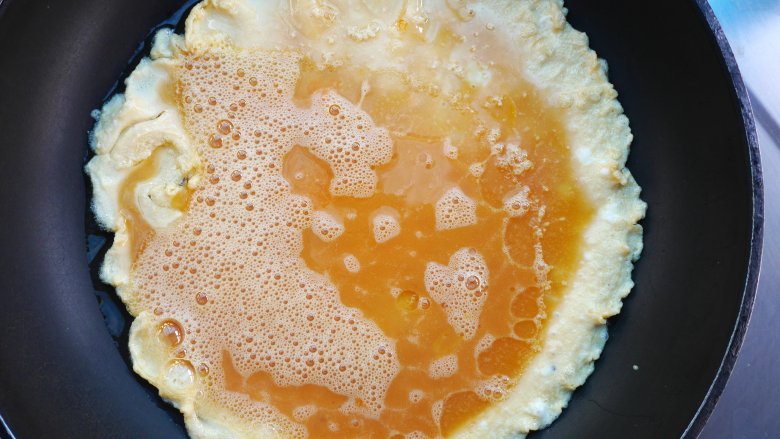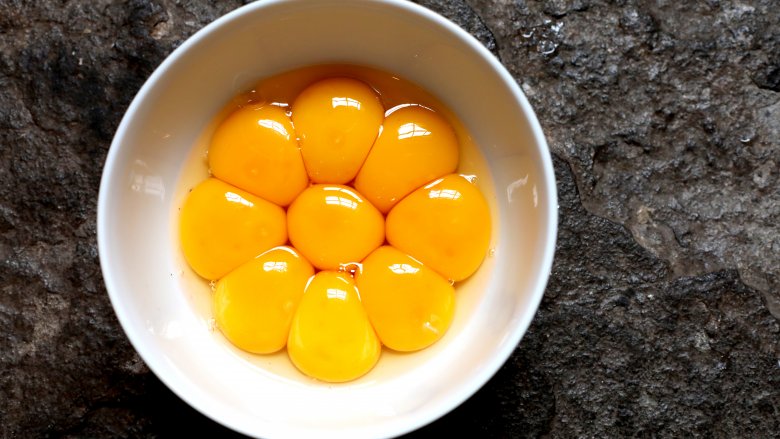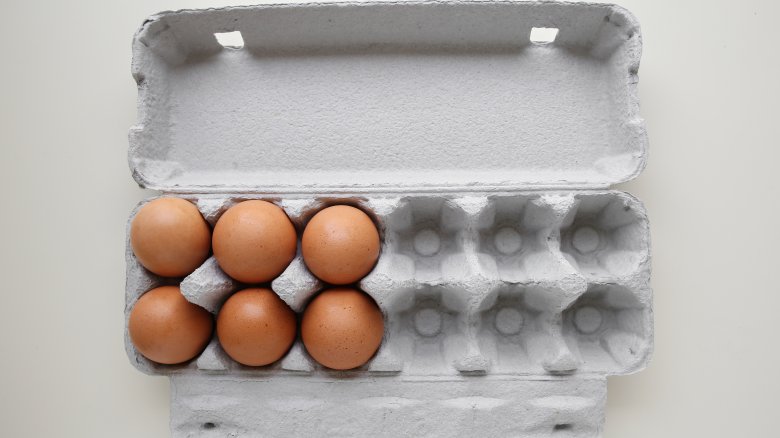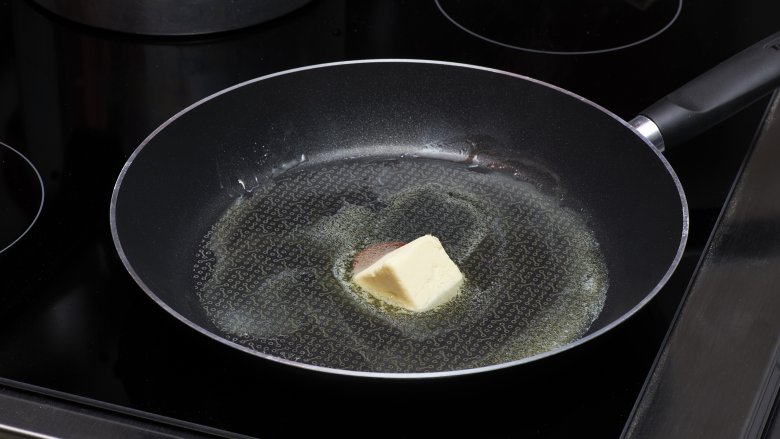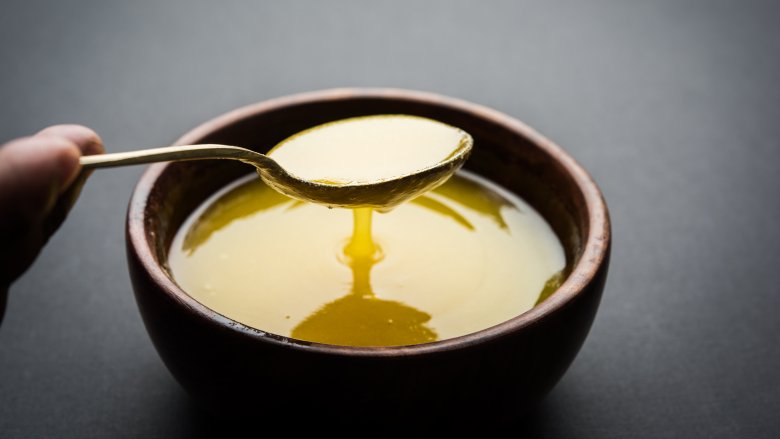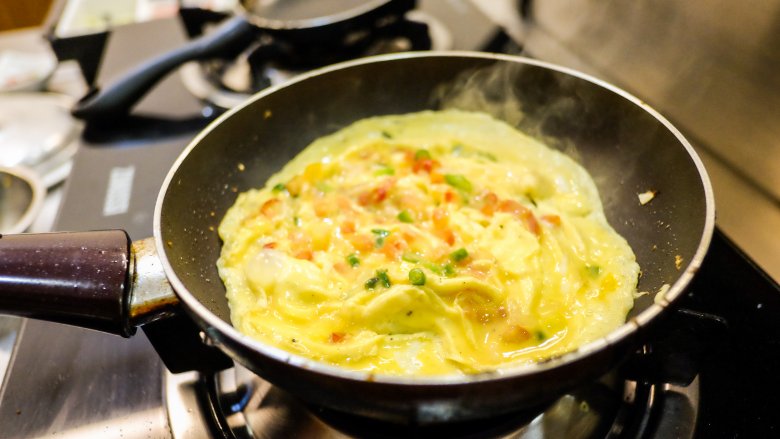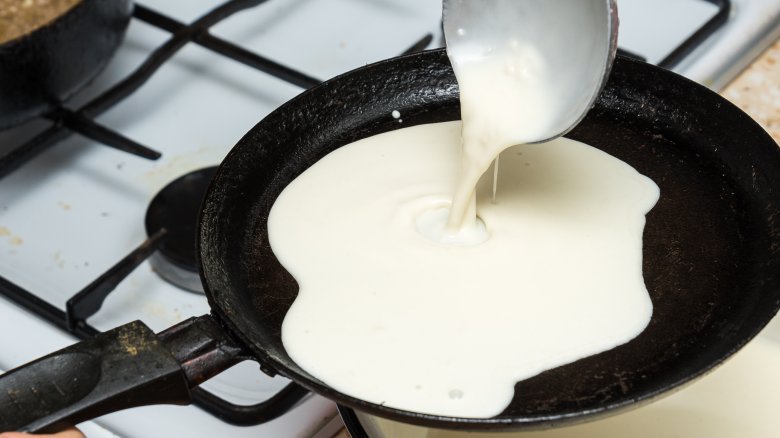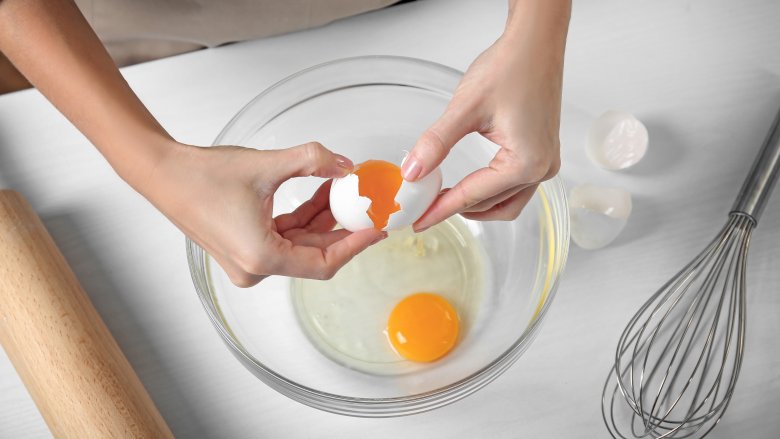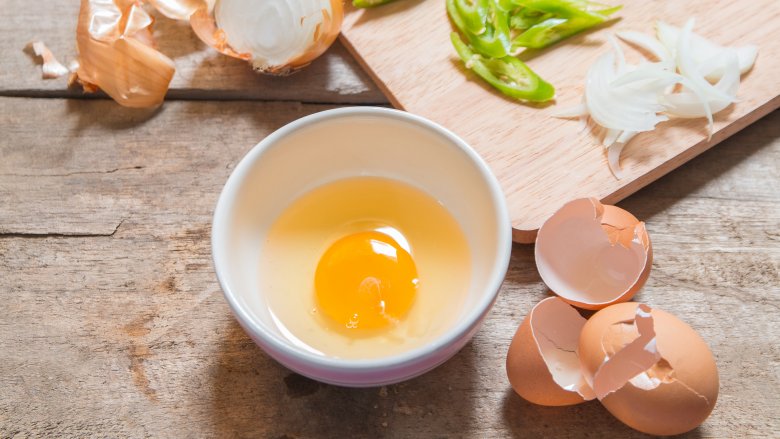The Biggest Mistakes Everyone Makes When Cooking Omelets
There are few foods more likable, well-rounded, and versatile than an omelet. You can eat them morning, noon, or night. Their star ingredient — egg, obviously — makes them a fantastic source of protein. Toss in some cheese, veggies, and roasted potatoes, and you've covered nearly all your nutritional bases. In other words, it's hard to go wrong with this one-pan wonder. Where you can go wrong, though, is in the preparation of this delicious dish. Suffice it to say, there are plenty of mistakes to be made when cooking omelets, and we're all guilty of making them (probably more than we'd care to admit).
Happily, there are far more cunning culinary talents in the world who are willing to share their tried-and-true tricks with the rest of us. The bad news is that mastering omelet-making isn't as simple as tossing a few eggs in a skillet and hoping for the best. It takes a bit of precision. Still, we can all agree that the pursuit of a perfect omelet is a worthy endeavor, yeah? Plus, if you're ever hosting a party and in a pinch for food, showing off your newfound omelet skills will undoubtedly impress your hungry guests.
But first, to get on the path towards omelet perfection, you'll need to know the biggest mistakes everyone makes when cooking them. Because, hey, it helps to know what not to do, right?
You're using the wrong size pan
You've pulled your ingredients out of the fridge and lined them up on the countertop like good little soldiers. Then you reach for your trusty frying pan — which, let's be honest, is probably your favorite because it's the only one in reach. It might be an oversized wok-style pan, or perhaps the time-worn iron skillet your grandma gave you. But here's the hitch: If it isn't the right size, you're setting yourself up for failure.
"Ask any chef ... and you'll find a pretty tight consensus that crafting the perfect omelet starts with the right number of eggs and the right size frying pan," insists kitchen accessory company Whiskware. The issue, per the company, is that using too large of a pan leads to a paper-thin omelet. To avoid winding up with a wimpy dish, Whiskware recommends sticking with a 7- to 8-inch frying pan.
So, while size may not matter everywhere, it kinda does when you're cooking omelets. Keep that in mind and grab a pan that will live up to your expectations.
You're not separating the whites
Raise your hand if you had no idea you were supposed to separate your egg whites out when making an omelet. (*Raises hand.*) Welp, count us today years old when we finally learned the truth, because this is reportedly an important step to achieving nirvana in omelet form.
To make a "super fluffy, souffléed omelet," you need to give the egg whites some proper attention. "Whip the whites with [a] pinch of salt until stiff peaks form and incorporate half of the mixture into the yolks with a whisk. Gently fold in the rest of the whites, spread into a pan, top with shredded cheese, cover, and cook for three minutes," suggests Lifehacker's food and beverage editor Claire Lower.
The Incredible Egg, the spokes-site for the humble egg itself, explains the logic behind this separation. "Fat from egg yolk will prevent egg whites from beating properly. When separating eggs, take care that no yolk gets in the whites." The site even goes so far as to suggest you should separate each egg white into a cup or small bowl before dropping it into the mixer bowl. Should you get even a speck of yolk in a white, toss it. Who knew?
You're getting carried away with toppings
Let us preface this by saying it's your life; you do you. Having said that, there are times when we can benefit from the expertise of others, and cooking omelets is one such time. Let food writer Karon Liu serve as a cautionary tale. Once upon a time, he couldn't make an omelet without it devolving into a sort of strange egg stir-fry. The culprit? He was overzealous when it came time to add the toppings.
In a 2014 article for the Food Network, though, Liu revealed he finally kicked his too-many-toppings habit. He elaborated that his best tip for omelet success is only using "up to three toppings at 1/3 cup each or 1/2 cup if you're only using two toppings." His prior method of tossing in anything in the fridge that struck his fancy turned out to be a major saboteur. "Loading your omelet with too much stuff would result in the egg ripping and becoming more of a scramble," he explained.
Before you start whipping up your next omelet, pump the brakes. Liu has one more piece of advice about toppings: Cook them accordingly. In other words, size up which take longer to cook than others (ingredients like mushrooms, onion, bacon, broccoli, bell peppers) and sauté them before you start your eggs. "I've had many hotel omelets when I'd bite into the eggs and taste raw mushrooms in the center. Don't do that," Liu advised.
You're not moving fast enough
Unless you're partaking of actual bitters, the term bitter isn't exactly one you want thrown about when describing your culinary creations. Yet, according to Allrecipes, that could very well be the verdict should someone taste an omelet that's unhurried. What's an unhurried omelet, you ask? Well, to be clear, that's anthropomorphizing. The only one not hurrying here is you, and it's quite likely going to earn you the opposite of a rave review in the kitchen.
While it may be tempting to take your sweet time cooking the eggs that will serve as your omelet's base, doing so is a disservice. Once the heat on your stove is really cranking, it's time for you to get hot, too. "The key, though, is to cook eggs quickly but gently," Allrecipes explains. "If the omelet gets too browned, it can taste a little bitter." And, c'mon, a bitter omelet sounds anything but appetizing.
Don't stress if you're unsure how to best cook eggs both rapidly and gently — there's a trick to it that's pleasantly simple. Says Allrecipes, "Tilt the pan, and with a spatula, lift up the omelet at the edge, allowing the raw egg to run underneath. This technique serves two purposes: One, the omelet cooks faster (without too much browning) when you run the raw egg off the top; two, it creates subtle layers of creamy fluffiness."
You're cracking too many eggs
What's that old idiom? Two eggs are better than one? Okay, so maybe that's not quite how the expression goes. However, if you ask any omelet-cooking expert, they'll likely deliver a similar line. Take, for example, Lacey Baier, the author at A Sweet Pea Chef. In her pursuit to discover the perfect egg-to-topping ratio, she pinpointed what she considers to be the ideal number of eggs to use in an omelet.
"I don't recommend trying to make a big omelet and then split it in two (or 3 or 4)," Baier writes on her blog. "We all want to cut breakfast prepping time in half (or lunch and dinner time for that matter) but making a big omelet and splitting it is not a good idea. You will end up with scrambled eggs instead of an omelet because flipping a huge omelet is not easy." Not mention, Baier points out, the more eggs you use the more likely it is that some of those eggs will end up undercooked.
Her advice? Start with two eggs. You can always add another egg white if you want to up your protein intake. Baier notes that you can, of course, crack a third egg if you're feeling ravenous. However, any more than three is overkill and merits a second omelet.
You're forgoing fresh ingredients
Who among us hasn't haphazardly whipped up on omelet using whatever ingredients we have on hand in the fridge? Whether it's the last few eggs that have been waning in the carton or some leftover steamed broccoli, you can't beat readily available ingredients for convenience. But just because you have them on hand doesn't mean they're going to give you the best omelet experience you could have.
In fact, Southern Living believes "the fresher, the better" should be your rule of thumb when it comes to making a killer omelet. "Fresh eggs make a world of difference when it comes to this breakfast staple," the outlet insists. Fortunately, simple clues can tell you just how fresh your eggs are. "If you're an avid farmers market shopper, you'll be able to see the color difference in straight-from-the-farm eggs compared to store-bought ones. Fresh, local eggs usually have vibrant, yellow-orange yolks — and your omelet will be much tastier (and colorful!) because of it."
The same logic applies to your omelet's fillings and toppings as well, so be sure to reach for those farm-fresh eggs and fresh produce next time an omelet craving hits.
You're tossing everything in the pan too early
Where Alton Brown leads, we shall follow. So when the Good Eats creator (slash Iron Chef America commentator, slash best-selling cookbook author) says we're messing up an important part of the omelet-making process, we take note. Not surprisingly, Brown is a wealth of knowledge when it comes to whipping up this delectable dish — but it's one particular piece of advice he offers that is low-key brilliant.
"Heat your pan empty for a few minutes before adding the butter," Brown advised as part of a recipe contribution for Food Network Magazine, "Even a nonstick surface is pocked with microscopic pores that eggs can fill and grab hold of. Heat expands the metal, squeezing these openings shut." Mind blown, right?
In case you're curious (as you should be in the name of a good omelet), Brown doesn't suggest spending an inordinate amount of time waiting for the pan to heat up. This extra, yet super-helpful step will only set you back two to three minutes, during which time you should have your sauté pan over medium to high heat. You'll also need to set aside 10 seconds after you begin cooking the eggs to let your omelet sit untouched to develop a proper outer crust. But when all is said and done, promised Brown, "Your patience will be rewarded."
You're using the wrong butter
To some of us, butter is butter is butter. It's all good and we'll take extra, please and thank you. However, and this may sound like sacrilege, there is such a thing as the wrong butter. Such is apparently the case when it comes to the butter you choose when you make an omelet. Domestic goddess Martha Stewart deemed it so.
In a 1997 issue of Martha Stewart Living, the maven made it clear that certain types of butter are undesirable for omelets because they're prone to burning. "Use clarified butter, which does not burn as quickly as salted or unsalted butter," said Stewart. "If you do use regular butter, watch carefully to keep it from burning."
Just think of clarified butter as liquid gold. As in, not only is it worth its weight in gold in the culinary world, but it quite literally looks like the molten precious metal, too. Although you're likely most familiar with seeing it used as a dipping sauce for lobster and other high-priced crustaceans, clarified butter boasts tons of versatility in the kitchen due to its very high smoke point — and that's why this beautiful butterfat (sans milk solids) is ideal for making omelets.
You're cooking it too long
An omelet's most winning trait — besides taste, of course — could arguably be that it's relatively quick and easy to create. Whether you were hungry before you started making it, or the smell of it cooking kicked your hunger into overdrive, you're always grateful that you can churn out an omelet in next to no time. But here's the thing: If you really want it to be the best omelet it can be, you're going to need to practice a bit of restraint.
Most of us presumably cook an omelet until the eggs are cooked all the way through. And while this seems like a sound approach, BBC Food recommends a different route. Per the site, you should "remove the pan from the heat, while the egg is still slightly runny in the middle." If you're now worried about foodborne illnesses like salmonella that come from eating something undercooked, don't be. Per BBC Food, "The residual heat will cook the egg and spinach." Residual heat, FTW!
You're not thinking outside the box
When you slide into a booth at IHOP and order an omelet, you know that what comes out of that kitchen is going to be a light-as-air blanket of eggs hugging cheese and other delicious fillings. On more than one occasion, you may even have wondered how they managed to make their omelet so gosh darn fluffy. Well, friends, as you suspected, IHOP has a secret ingredient. What you probably didn't expect is that their secret ingredient is pancake batter.
"By adding a small amount of pancake batter to its eggs, IHOP accomplishes a few things," The Daily Meal revealed. "One, it adds some structure to the eggs, making them a little more sturdy and filling. Two, the extra moisture leads to a fluffier overall product. And three, it adds just the slightest amount of tasty pancake flavor to the mix."
This means that somewhere along the way, someone in IHOP's kitchen did some serious outside-of-the-box — or better yet, inside of the pancake box — thinking when cooking an omelet, and the result is a dish that is delightful and distinctive in equal measure. Moral of the story? Don't be afraid to experiment while endeavoring to create the perfect omelet, because you might just stumble upon your own very special star ingredient.
You're prepping the eggs wrong
The culinary world considers Jacques Pépin a big deal, and for good reason. In addition to being an iconic cooking show host in his own right, the legendary French chef rubbed elbows with the likes of Julia Child. So, in 2013 when Buzzfeed wanted a demonstration of how to make the perfect omelet, of course they tapped Pépin.
Right out of the gate, things got interesting. After quickly walking readers through the right size skillet (eight inches) and "fines herbs" (chives, parsley, tarragon and chervil), Pépin stressed the importance of cracking eggs correctly. As in, oops, we've all been cracking eggs wrong all along. The secret, per Pépin, is cracking your eggs on a surface such as the counter. "When you crack on the bowl, the shell gets pushed inside the egg, not good," explained Pépin.
And that's not all. Once you've cracked the eggs correctly, you should be taking another egg-prep step that you've likely been overlooking. Before you whisk the eggs, pierce the yolks with a fork — this makes it easier to blend everything together. This is crucial, because after seasoning the eggs with salt and pepper, you must whisk them with the other ingredients vigorously. "Don't go slowly here," Pépin cautioned. Your eggs need to be extremely well-blended before the omelet-cooking can begin. And here we've just been cracking our eggs on the bowl and plowing forward. Tsk, tsk!
You're overcomplicating things
Betcha didn't realize so much went into making an omelet, huh? Sure, cooking an omelet is essentially an art form. But let it be said that getting too lost in the inner workings of making an omelet can have effects just as disastrous as ignoring all of the advice cataloged here. The Pioneer Woman's blog said as much, so it must be true.
In an article on Drummond's massively popular site in 2016, food blogger Erica Lea confessed that her first few attempts at making omelets turned out to be a disaster. She could pinpoint her main issues easily enough: Too much milk in her eggs, too much filling, and trying to make her omelets look fancy enough for a diner table. Yet, it took her a hot minute to connect the dots. "I finally realized that I was overcomplicating things. So I simplified my process, and suddenly my omelet game improved immensely," she said.
Lea's pared down but winning method entails two eggs with a little salt (well-whisked with a fork), a decent gob of butter (because "omelets are thirsty things!"), a handful of cheese paired with a few precooked fillings like mushroom and bacon, and a carefully timed fold. That's pretty much it. The moral of the story? When in doubt, keep it simple.
